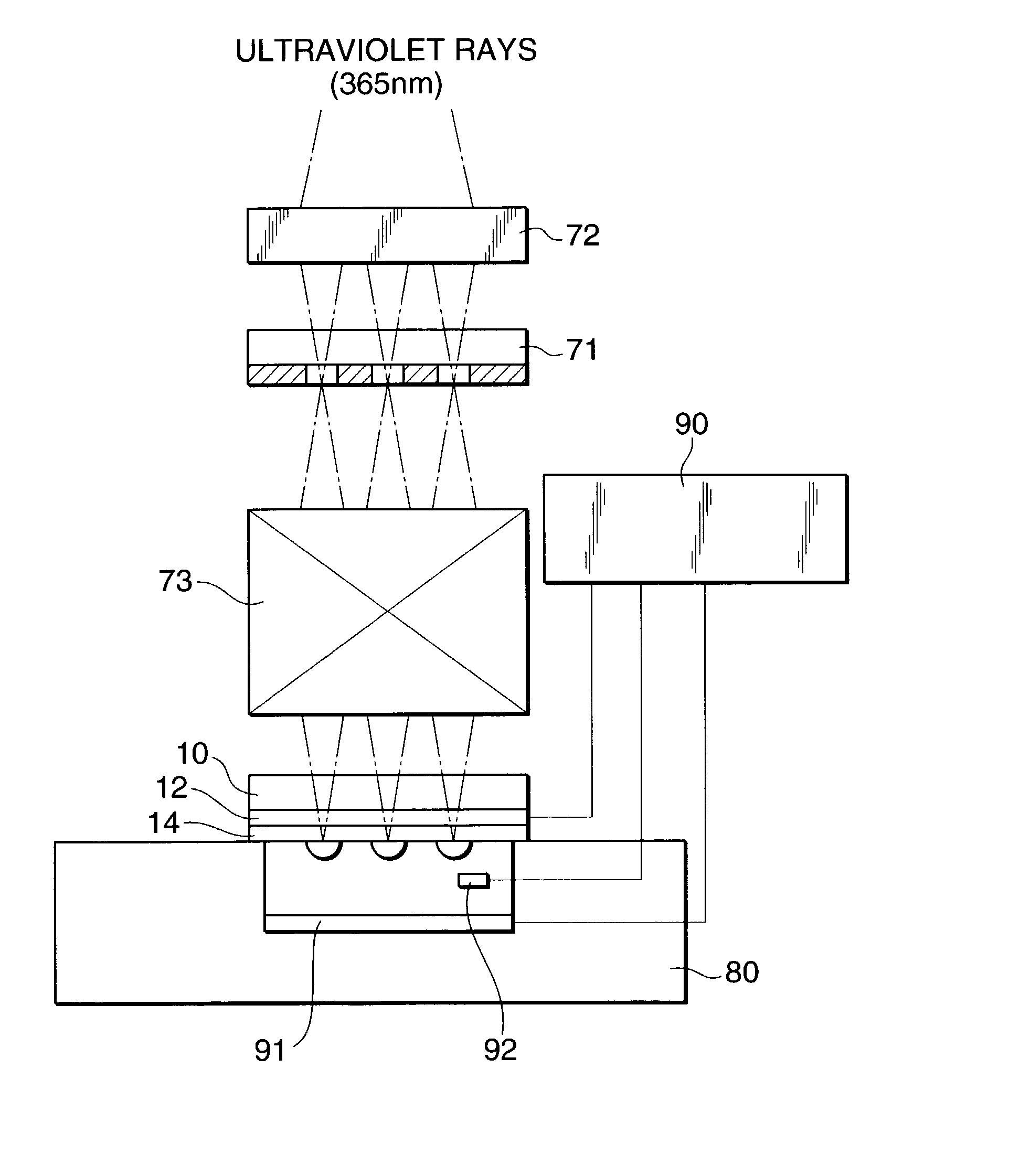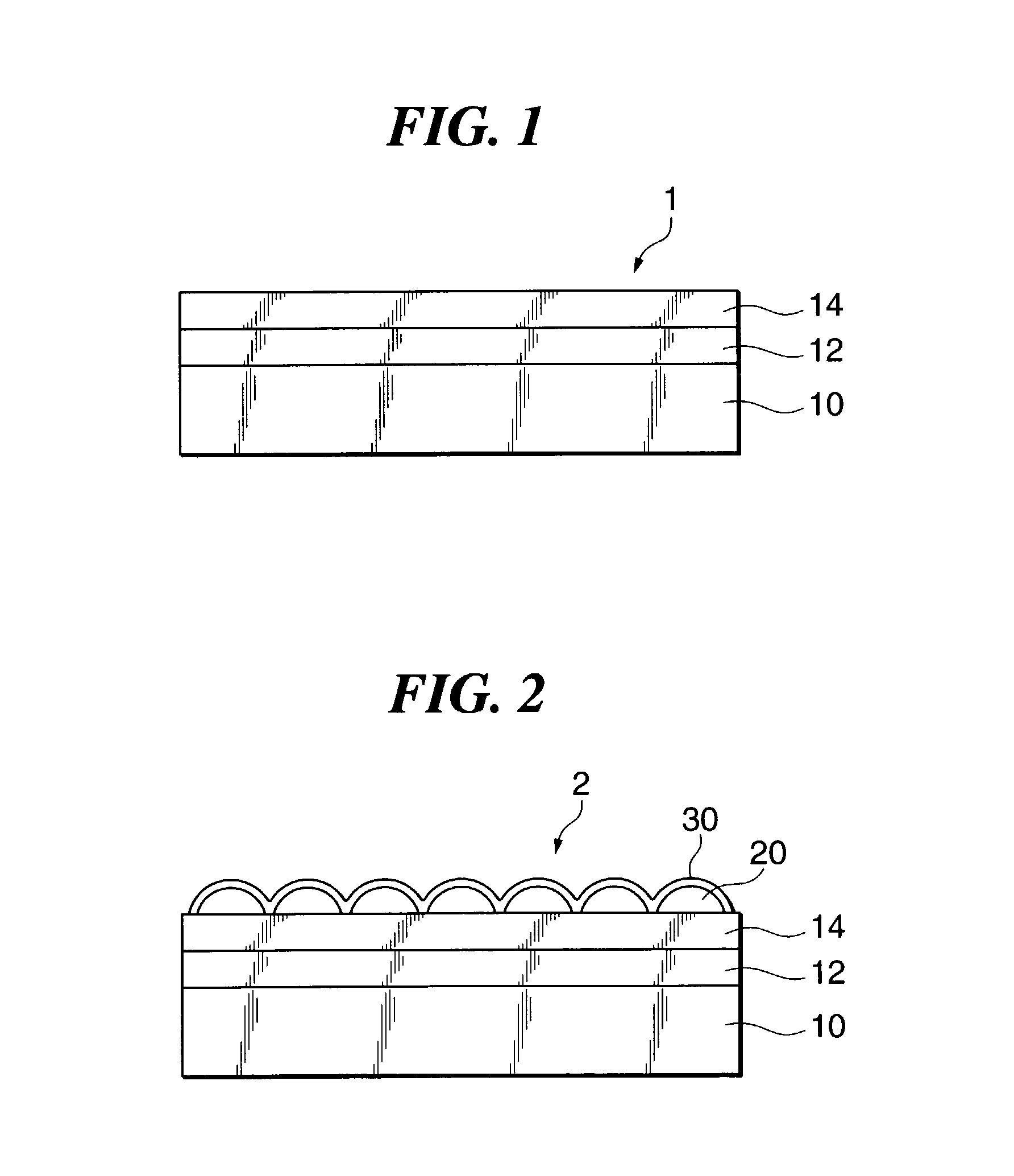Method of manufacturing micro-lens array, electrolyte and manufacturing apparatus used therefor
a manufacturing method and technology of micro-lens array, applied in the field of manufacturing micro-lens array, electrolyte and manufacturing apparatus used therefor, can solve the problems of difficult curvature control of lens, long etching time of etching method, and difficult control of lens curvatur
- Summary
- Abstract
- Description
- Claims
- Application Information
AI Technical Summary
Problems solved by technology
Method used
Image
Examples
example 1
[0100] 75 nm of an ITO film and 110 nm of an anatase type thin titanium oxide film were formed by an RF sputtering method on an alkali-free glass substrate (7059 glass) of 0.4 mm in thickness to prepare a micro-lens array preparing substrate.
[0101] Then, an electrolyte including an aqueous liquid dispersion containing transparent fine particles (solid content: 10 mass %) was prepared by dispersing rutile type fine titanium oxide particles (grain size: 10 nm, refractive index: 2.7), styrene-acrylic acid copolymer (molecular weight: 13,000, molar ratio for hydrophobic group / (hydrophilic group+hydrophobic group): 0.65, acid value: 150) at a 1:5 volumic ratio, adding 5 mass % of ethylene glycol and further, using tetramethyl ammonium hydroxide and ammonium chloride to control pH to 7.8 and conductivity to 6 mS / cm.
[0102] A three-electrode type customary electrodeposition apparatus in electrochemistry shown in FIG. 3 was used and a TiO.sub.2 thin film as a micro-lens array preparing subst...
example 2
[0110] Electrodeposition was conducted by use of the same micro-lens array preparing substrate, photo-mask, electrolyte and electrodeposition conditions as those in Example 1 except for using a micro-lens array manufacturing apparatus shown in FIG. 4. A mercury xenon lamp (manufactured by Yamashita Denso Corporation, light intensity: 50 mW / cm.sup.2, wavelength: 365 nm) was used as the exposure device and the photo-mask was made in intimate contact with the glass substrate of the micro-lens array preparing substrate.
[0111] Further, heat treatment was applied at 150.degree. C. in the same manner as in Example 1 and a 96-nm SiO.sub.2 film was formed to obtain a micro-lens array.
[0112] The same micro-lens array as in Example 1 was obtained.
example 3
[0113] Electrodeposition was conducted by use of the same micro-lens array preparing substrate, photo-mask, electrolyte and electrodeposition conditions as those in Example 1 except for using a laser beam exposure device instead of using the projection type exposure device used in Example 1. A laser beam exposure device using an He--Cd laser, operationally associated with a Galvano scanner and an AO modulator and capable of turning on and off the laser beam at a predetermined position was used. The laser beam was formed as a Gaussian beam in which the intensity of light was increased toward the beam center and decreased toward the periphery. Exposure was conducted while scanning by the exposure apparatus.
[0114] Further, heat treatment was applied at 150.degree. C. in the same manner as in Example 1 and a 96-nm SiO.sub.2 film was formed to obtain a micro-lens array.
[0115] The same micro-lens array as in Example 1 was obtained.
[0116] The method of manufacturing the micro-lens array ac...
PUM
| Property | Measurement | Unit |
|---|---|---|
| diameter | aaaaa | aaaaa |
| heat resistance | aaaaa | aaaaa |
| heat resistance | aaaaa | aaaaa |
Abstract
Description
Claims
Application Information
 Login to View More
Login to View More - R&D
- Intellectual Property
- Life Sciences
- Materials
- Tech Scout
- Unparalleled Data Quality
- Higher Quality Content
- 60% Fewer Hallucinations
Browse by: Latest US Patents, China's latest patents, Technical Efficacy Thesaurus, Application Domain, Technology Topic, Popular Technical Reports.
© 2025 PatSnap. All rights reserved.Legal|Privacy policy|Modern Slavery Act Transparency Statement|Sitemap|About US| Contact US: help@patsnap.com



